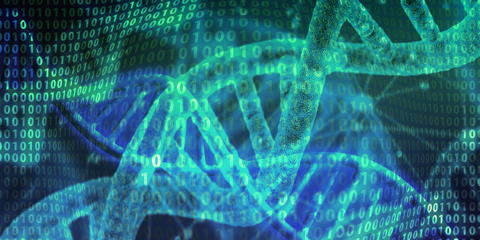
Home | Bio | Music | Software | Teaching
Notes
for electronic sound
by Reginald Bain
Genetic Variations (2022) is an electronic music composition that explores musical analogies for genetic mutation. It employs sonification-inspired mapping techniques and algorithmic processes. The algorithmic processes were realized using SuperCollider, a real-time audio synthesis programming language and environment for algorithmic composition.
The work is presented in four movements: I. SINES, II. Transposable Elements, III. Microsatellite, and IV. Chain. Each movement focuses on a different mutational theme and related sonification of genetic data that is framed with electronic music. The sonification approach employed is parameter-mapping sonification; i.e., a DNA sequence, or in the case of the fourth movement an amino acid sequence, is mapped to musical parameters to create melodies and harmonies – a technique sonification researchers call musification (Grond and Berger 2011).

To make the work accessible to a broader public, the composer employed classic synthesis techniques (additive, subtractive, wavetable, and physical modeling synthesis), and in the two outer movements attempted to sonify the genetic data in a manner that would create familiar-sounding melodies and harmonies. To portray the random nature of mutations (Loewe 2008), pseudo-random chance procedures are employed throughout the work. For example, pitches and durations are randomly selected at times, control signals are derived from noise signals, and stochastic mixing techniques are employed. To portray the microbiological world in which mutations take place, micro-rhythms and microtonal pitch systems are employed. To suggest natural growth patterns, the Fibonacci sequence is employed.
The first movement, titled SINEs, opens with music sculpted from sine waves. In genetics, the acronym SINEs stands for short interspersed nuclear elements. The genetic data sonified in this movement is the Alu SINE’s DNA sequence. Alu elements are mobile elements of the human genome that are free to accumulate mutations over time because they are often located in non-coding regions of our DNA (Deininger 2011; Vassetzky and Kramerov 2012).
The second movement, titled Transposable Elements, features a sonification of the human gene THAP9. A transposable element is a DNA sequence that can change its position within a genome. Genetic research has recently uncovered that THAP9 bears homology to the fruit fly Drosophila’s P element transposase (Majumdar & Rio 2015). Random pitch selections, inflections, and glissandi are employed to paint a sonic microworld that is filled with random mutations.
The third movement, titled Microsatellite, is the most complex of the four movements. In a microsatellite mutation – also called a short tandom repeat – a short DNA motif of about 2-6 base pairs in length is repeated about 5-50 times. In this movement, a very short DNA sequence fragment (Dudycha 2018) is turned into a 2-voice tempo canon that is looped and varied to create extremely dense contrapuntal fabrics that unfold in a microtonal space; specifically, a 17tet vs 31tet polytuning. The movement culminates in an algorithmically-generated dinucleotide microsatellite mutation.
The fourth and final movement, Chain, explores mutation in the context of the Insulin gene. Genetic research has associated mutations in the Insulin gene with diabetes. The title of the movement refers both to the four-segment structure of its amino acid sequence (Signal Peptide, B-Chain, C-Peptide, and A-Chain) and to the movement’s unusual form. Random bells set the stage. A slow introduction introduces the Insulin gene's amino acid sequence via a 110-tone pitch row. The sequence is then sonified to create a familiar-sounding prestissimo theme. Finally, the work concludes with three jubilant variations of the Insulin theme inspired by recent research on gene mutations associated with diabetes (Støy, et al. 2021).
The world premiere of Genetic Variations took place at the USC Computer Music Concert, University of South Carolina, School of Music, Recital Hall, (Columbia, SC) on April 24, 2022.
| I. | SINEs | 1:29 |
| II. | Transposable Elements |
4:33
|
| III. | Microsatellite | 1:50 |
| IV. | Chain | 4:19 |
| D U R A T I O N: | 12:31 | |
SuperCollider, a platform for audio synthesis and algorithmic composition
Bain, Reginald. 2021. “Seed, from Double Helix.” Proceedings of the 26th International Conference on Auditory Display (ICAD). ICAD 2021 Sonification Concert. {ICAD.org}
Deininger, Prescott. 2011. “Alu elements: know the SINEs.” Genome Biology 12/336 (December 2011). {BMC}
Dudycha, Jeff. 2018. "Introduction to Mutations." BIOL 599 Topics in Biology: Chords and Codons course handout. University of South Carolina. Unpublished.
Grond, Florian, and Jonathan Berger. 2011. "Parameter Mapping Sonification." In The Sonification Handbook, edited by T. Hermann, A. Hunt, J. G. Neuhoff, Berlin: Logos Verlag, pp. 363–397. {Sonification.de}
Loewe, Laurence. 2008. "Genetic Mutation." Nature Education 1/1: 113. {Nature Education}
Majumdar, Sharmistha and Donald C. Rio. 2015. "P transposable elements in Drosophila and other eukaryotic organisms." Microbiology Spectrum 3/2. {PubMed.gov}
Støy, Julie. et al. 2021. "In celebration of a century with insulin – Update of insulin gene mutations in diabetes." Molecular Metabolism 52 (October 2021). {PubMed.gov}
Vassetzky, Nikita S. and Dmitri A. Kramerov. 2012. "SINEBase: A database and tool for SINE analysis." Nucleic Acids Research 41 (January 2013). {PMC}
This composition was created for the Mutational Music Project, the broader impact component of the National Science Foundation (NSF) grant project Mutational variance of the transcriptome and the origins of phenotypic plasticity (NSF award #1556645). Jeff Dudycha is the principal investigator and Reginald Bain is the other senior person on the grant.

Updated: May 14, 2024